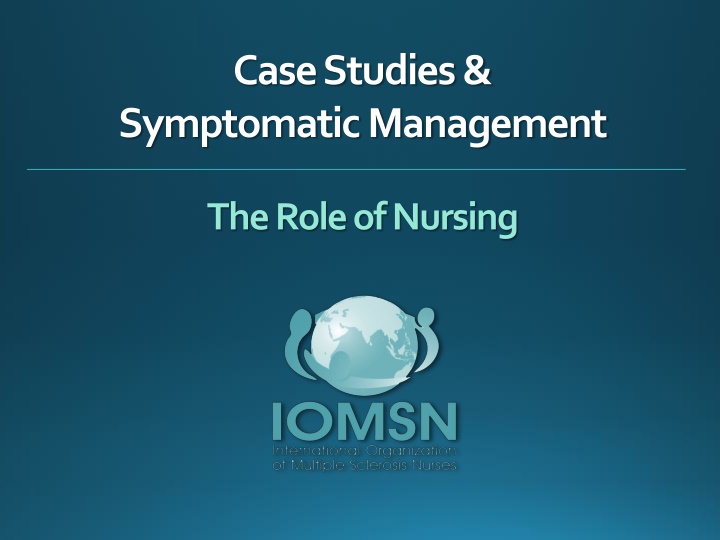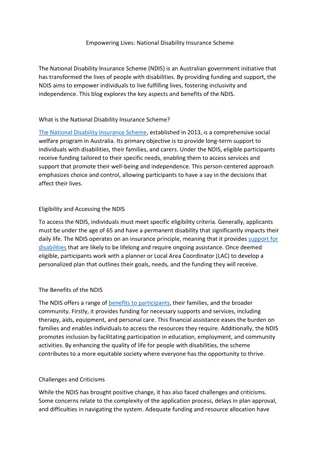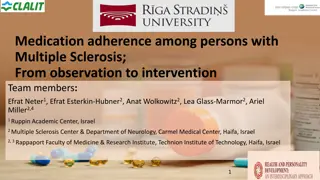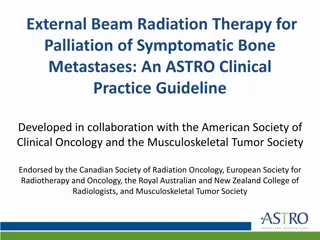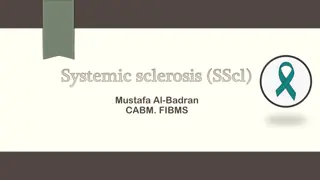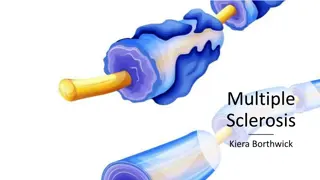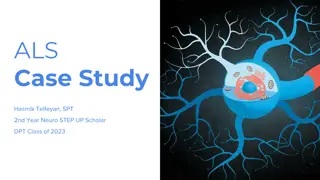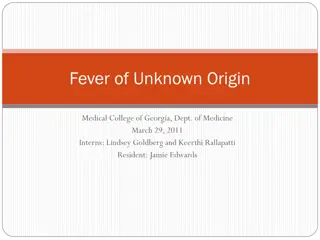Managing Multiple Sclerosis with Symptomatic Nursing Care
Cathy, a 32-year-old woman with MS, has been on glatiramer acetate for 3 years. Learn about the role of nursing in providing symptomatic management for patients with MS.
Download Presentation

Please find below an Image/Link to download the presentation.
The content on the website is provided AS IS for your information and personal use only. It may not be sold, licensed, or shared on other websites without obtaining consent from the author.If you encounter any issues during the download, it is possible that the publisher has removed the file from their server.
You are allowed to download the files provided on this website for personal or commercial use, subject to the condition that they are used lawfully. All files are the property of their respective owners.
The content on the website is provided AS IS for your information and personal use only. It may not be sold, licensed, or shared on other websites without obtaining consent from the author.
E N D
Presentation Transcript
Case Studies & Symptomatic Management The Role of Nursing
Case Study 1: Cathy 32-year-old woman working full-time at marketing firm Diagnosed with MS 10 years ago; immediately started disease modifying therapy Treated with glatiramer acetate (Copaxone) for 3 years Switched to interferon beta-1a sc (Rebif) due to: Relapse activity Accumulating residual symptoms Increased lower extremity tone Numb feet Bladder symptoms Enhancing lesions on MRI Stable on interferon beta-1a sc for 5 years
Case Study 1: Cathy Cathy started to have significant skin problems and pain on injection Requested a switch to oral therapy Started on fingolimod (Gilenya) which was well-tolerated After 3 months, however, had a significant relapse causing right-sided weakness which required steroids Neurologist recommended staying on fingolimod since she had been on this treatment for only a short time 8 months later, MRI showed 7 new supra-tentorial white matter lesions but no new enhancing lesions
Case Study 1: Cathy Post-MRI Annual Review Cathy is feeling very well All previous relapse symptoms had resolved completely Neurological exam returned to pre-relapse baseline Continued to tolerate fingolimod very well Blood work within normal limits Cathy made aware of most recent MRI results but did not want to switch DMT therapy since she was reassured that there were no active lesions and she wanted to give fingolimod more time to work Husband accompanied her on visit and voiced concerns about efficacy of fingolimod since Cathy had been so stable on interferon beta 1-a sc
Case Study 1: Cathy Discussion Points Is Cathy s MS being adequately treated? How would you counsel Cathy and her husband on the status of her disease? Would you encourage Cathy to switch to another therapy? Which one? What other treatment options would you consider for Cathy?
Case Study 2: Brandi 35-year-old married woman with relapsing remitting MS MS became apparent during her first pregnancy Sudden onset of right leg weakness and tingling Urinary urgency and frequency Bowel urgency with one episode of incontinence Band-like sensation on right side of torso Post-pregnancy MRI revealed 19 supraventricular lesions 2 cerebellar lesions 2 pontine lesions Multiple lesions of C-spine
Case Study 2: Brandi Brandi was seen for follow-up at MS clinic for DMT teaching and initiation but refused because she was contemplating a second pregnancy 6 months later she experienced another clinical relapse Vertigo Tinnitus Double vision Sensory changes to the right upper extremity Refused DMT again but did receive high-dose oral steroids and had a complete recovery
Case Study 2: Brandi Brandi was able to conceive again, and enjoyed clinical stability throughout her second pregnancy 2 months after the birth of her second child Had sensory relapse involving left upper and lower extremities Balance also impacted Sought help at MS clinic for her relapse but did not pursue steroid therapy because she was nursing her new baby Encouraged to pursue DMT as soon as possible Chose to defer therapy in favor of nursing her child for as long as possible
Case Study 2: Brandi Discussion Points Is it wise for Brandi to wait to start DMTs until she is finished nursing? Would you consider initiating any DMTs and allowing her to continue nursing? Would you encourage her to stop nursing at this time? What factors would you consider when educating Brandi about her disease course?
Case Study 3: Michael 28-year-old single man working as an electrician 2 year history of relapsing remitting MS Initial symptoms Transverse myelitis 6 months later, optic neuritis Shortly after diagnosis, began High dose interferon beta 1-a sc (Rebif) No difficulties with self-injection But unable to tolerate the flu-like symptoms Adherence to therapy sub-optimal On advice from his maternal aunt, a naturopath, Michael considered more natural therapies and doubted the value of his current DMT
Case Study 3: Michael 10 months after initiation of interferon beta 1-a sc, Michael experienced an additional sensory relapse Follow-up MRI showed Scattered new brain parenchymal white matter lesions in the right parietal lobe, bilateral frontal lobes, brainstem, and cerebellum Several lesions were noted to enhance Neurologist recommended that he switch his DMT to natalizumab (Tysabri) or fingolimod (Gilenya) Michael was overwhelmed with the MRI results and the magnitude of the new disease activity He declined to make a treatment decision Stated that both DMT medications would kill him Broke down at meeting with his MS nurse Expressed feelings of defeat and hopelessness
Case Study 3: Michael Discussion Points What are your concerns about this patient? What would your first nursing interventions be? Who would you involve in his care? Would you push him to start DMT therapy and if so, which one?
Case Study 4: Valerie 57-year-old woman with a 26 year history of primary progressive MS Currently using a wheelchair for mobility when out but using a walker at home Suffers from significant neuropathic pain, depression, advanced neurogenic bladder, and spasticity Lives independently in one-level condominium with home care help Marriage broke up 10 years after her diagnosis, but has some help from her daughter who has remained close Both Valerie s daughter and home health aide are increasingly concerned about Valerie s mood, pain, constipation, and lower limb spasticity
Case Study 4: Valerie Valerie s current medications include Baclofen 20 mg po qid Tizanidine(Zanaflex) 4 mg qid Citalopram (Celexa) 20 mg daily Clonazepam (Rivotrel/Klonapin) 1 mg tid for sleep and anxiety Tramadol 37.5/acetaminophen 325 (Tramacet) 2 tabs every 6 hrs Codeine 30 mg/acetaminophen 300 mg (Tylenol #3) for severe pain She is struggling with bladder incontinence and wearing adult diapers at all times. Recent urine was negative for infection
Case Study 4: Valerie Valerie is fiercely independent and manages all her own medications Daughter describes her as angry and reclusive since her diagnosis Has refused most rehabilitation interventions to date Reports to the clinic in the company of her daughter for assessments Appears notably drowsy Lower limbs both stiff and movement provokes spasms and moans of pain Tells clinic team that she will be fine and she just needs more medication for the pain
Case Study 4: Valerie Discussion Points What is the most concerning symptom that Valerie is experiencing? What MS symptoms need to be managed differently? What changes could be made to her current management strategies? Is Valerie safe living alone?
Case Study 5: Fred 32-year-old man with acute MS symptom changes Works long days as a heavy equipment operator for a road construction company Recently ordered off work because symptoms raised safety concerns 7 year history of relapsing remitting MS Previously treated with dimethyl fumarate (Tecfidera) but stopped for intolerance Started second DMT, pegylated interferon 1-a (Plegridy) 6 months ago Experienced an episode of left optic neuritis after starting pegylated interferon 1-a but claims his vision recovered completely
Case Study 5: Fred Now reporting 10 day history of right-sided sensory loss Impacting his ability to operate a large tractor on road work site Frantic to return to work because he has 3 school age children at home and his wife is not currently employed Tells the MS team to treat him and fill out the necessary return-to-work forms so he can get back out there Currently in a contract position with limited sick benefits
Case Study 5: Fred Examination Vision without glasses 20/80 in left eye, 20/60 in right eye, 20/60 together Moderate degree of sensory loss by pin prick to right fingers, hand and arm Diminished vibration sensation and pinprick numbness of right foot Mild weakness of lower right extremity Walks unassisted but unsteady on tandem walking Complained of urination urgency and frequency (recent culture was negative) Other medications: modafinil (Provigil/Alertec), solifenacin (Vesicare), Vitamin D 4000 IU
Case Study 5: Fred Discussion Points Is this a true MS relapse? How would you treat his current symptoms? Do you feel his MS is being adequately treated by pegylated interferon-1a? What other MS symptoms are a concern to you? What return-to-work plan would you recommend for Fred?
Case Study 6: Judy 34-year-old woman, married with 2 children, ages 5 and 7 Works part-time as a receptionist in a dental office Wellness-focused lifestyle including exercise and very healthy eating habits Diagnosed with relapsing remitting MS 4 years ago Started beta interferon 1-a sc (Rebif) but stopped after 5 months due to flu-like symptoms which interfered with her exercise routine Prescribed dimethyl fumarate (Tecfidera) but stopped after 3 months because of allergic reaction (generalized hives)
Case Study 6: Judy Over the past 13 months, Judy has had 3 relapses Had significant residual dexterity loss of her right dominant hand after last relapse Numerous enhancing lesions on recent MRI Neurologist recommended starting natalizumab (Tysabri) as soon as possible She is reluctant to try new DMT and has looked into alternative treatments including restrictive diets and stem cell therapy in Mexico She would prefer a more natural, non-chemical approach for treating her MS
Case Study 6: Judy Discussion Points How would you approach education on treatment? Would you encourage Judy to try alternative therapies? How would you discuss the seriousness of her current MRI findings? How might you suggest combining safe, complimentary therapies with an effective DMT?
Case Study 7: Ron 49-year-old man diagnosed with secondary progressive MS Significant lower limb weakness and spasticity Spends most of his time in a wheel chair Able to take a few steps unaided Independent in dressing and toileting Works full-time in brother s office as an accountant Family is very supportive
Case Study 7: Ron Ron calls to report sudden onset of severe pain in his mid- cheek and lower jaw area Describes pain as explosive and happens when he chews or talks Unable to brush his teeth since pain began Saw a physician at urgent care center and was started on gabapentin and escalated his dose to 2400 mg daily Helped somewhat but still has intolerable pain and unable to chew or handle oral care His neurologist started him on carbamazepine (Tegretol) 200 mg tid
Case Study 7: Ron Carbamazepine worked well but he became so weak and dizzy that he stopped it Currently off work since spasms of pain occur when he is talking to clients Desperate to be pain free and back to regular work schedule Family cruise to celebrate his 50thbirthday is scheduled to take place in 5 weeks Knows he can not go on cruise feeling the way he does now
Case Study 7: Ron Discussion Points What is the source of Ron s pain? Has his recommended treatment been appropriate? Is this an MS relapse? What other treatment strategies/medications might be considered?
Case Study 8: Ashley 44-year-old woman with a 9 year history of relapsing remitting MS Widowed 2 years ago; lives with oldest daughter and helps with chid care of 2 grandchildren ages 3 and 7 Limited contact with 2 other grown children who attend college in other cities Stable since onset with DMT interferon beta 1-a sc (Rebif) 6 months ago, switched to teriflunomide (Aubagio) because of skin issues Tolerating new medication well and blood work (CBCD and liver enzymes) is normal
Case Study 8: Ashley Troublesome MS symptoms include: Minor neuropathic pain in lower extremities - managed by pregabalin(Lyrica) 50 mg tid Significant bladder issues impacting quality of life - 2 UTI s in 6 months, gets up several times at night, dribbling urine through the day Ashley is feeling housebound Only goes places with ready access to a bathroom Unable to help with her grandson s afterschool activities for fear of incontinence Taking fesoterodine(Toviaz) 8 mg daily but no longer helping her and wonders if she should continue She is new to the MS clinic and has never had formal bladder assessment
Case Study 8: Ashley Discussion Points What would a comprehensive bladder assessment include? Is MS the cause of her current bladder problems? What other issues could be contributing to her current bladder problems? Is fesoterodine an appropriate medication for this symptom?
Case Study 9: Justin 31-year-old single man with a 3 year history of very active relapsing remitting MS Employed in sales department of car dealership and has a very active social life Initially started teriflunomide (Aubagio) but experienced a significant brain stem relapse which required steroids Vertigo Double vision Right facial droop MRI showed several new enhancing lesions Started on alemtuzamab (Lemtrada) 6 months ago Recent MRI stable; no evidence of active disease Justin has gone back to work and feels very well
Case Study 9: Justin Resumed his social activities, has new girlfriend, recently moved MS team is concerned as he is not adherent to monthly blood monitoring His patient support nurse is never able to reach him and he hasn t answered her email reminders for lab monitoring Missed 1 month of blood work and was 2 weeks late another month; didn t notify clinic of change of address/phone; clinic secretary had to call him at work to schedule follow-up When challenged about the lack of adherence to lab follow up, he states he leads a busy life and he s doing just fine Neurologist wants MS nurse to meet with Justin to reinforce compliance with laboratory monitoring
Case Study 9: Justin Discussion Points How would you approach the issue of Justin s nonadherence? What strategies might help Justin to be more adherent to follow-up monitoring? Who else might you involve in strategies to help Justin? Do you feel it is appropriate to consider withholding his second course of alemtuzumab if adherence does not improve?
Case Study 10: Eric 22-year-old single black man referred to MS center by a family practice NP History of visual symptoms (diplopia) in early 2013 which improved completely with no medical care October 2105 experienced Unsteady gait Mild slurred speech Reoccurrence of double vision By December 2015, symptoms worsened, had severe trouble walking, speaking, and was admitted to hospital MRI at hospital showed severe burden of white matter disease consistent with MS
Case Study 10: Sylvia 30-year-old woman, diagnosed at age 20 with relapsing MS Early in her disease, had 2 3 mild relapses (all sensory, no disability) Reluctant to start DMT until cranial MRI showed increasing lesion burden Started injectable therapy at age 26 but not consistent with her dosing Other therapies initiated (another injectable, IV and oral therapy) but she stopped them because of Side effects Her perception of lack of efficacy Out-of-pocket expenses
Case Study 10: Sylvia Often missed every other scheduled office visit Recently married (3 months ago) and would like to discuss plans to become pregnant Spouse scheduled to be at appointment but cancelled at last minute. During visit, she shared that spouse divorced 1 year prior to their marriage; there are 3 children from previous marriage Sylvia has been off treatment for 3 months MRI and EDSS Current MRI shows multiple enhancing white matter lesions Most recent EDSS is 4.5; 6 months ago, EDSS was 2.0
Case Study 10: Sylvia Sylvia was recently added to her spouse s insurance but is in a waiting period Covered by Consolidated Omnibus Budget Reconciliation Act (COBRA) insurance for another 3 months Reluctant to discuss active therapy as she has heard that pregnancy stabilizes MS The couple anticipates a move to another state within a year due to her spouse s employment
Case Study 10: Sylvia Discussion Points What is your assessment of this patient? What are her primary needs? What are the educational needs of this patient and her family? Should treatment be initiated?
Case Study #11: Kara 37 year old woman, 6 yr history of relapsing remitting MS. In common law relationship, 4 year old son Was on dimethyl fumarate for 18 months post birth of son, but flushing became intolerable and so adherence was poor MRI active particularly in spine Was worked up and eligible for ocrelizumab Patient was a bit undecided about initiating therapy as concerned about more A/E s contributing to not being able to work and care for her son Mild sensory relapse convinced her to commence therapy
Case Study 11: Kara First Infusion Premedication (methylprednisolone, diphenhydramine and acetaminophen) At 11:00 am infusion commenced. One hour into infusion patient experienced flushing and itchiness in ears, neck, upper chest resolved in 30 minutes. Then noticed bilateral blurred vision and tightness to base of neck that migrated to chest and throat. IV rate adjusted per protocol. Medication fully infused at 3:00 pm. Patient observed for additional hour post infusion, and all infusion symptoms had resolved 3 days following infusion patient experienced nausea, vomiting, diarrhea and the return of squeezing sensation to neck and chest Assessed in clinic and no signs of allergic reaction, denied other heath/social issues Advised to keep the clinic posted. Patient made several additional calls to clinic with similar symptoms which eventually resolved
Case Study 11: Kara Discussion Points Are these reported symptoms likely drug related? Were management strategies appropriate? What other concerns might you have?
Case Study 11: Kara Outcome Nurse phoned patient for pre-second infusion assessment Patient reported that she was currently living a woman s shelter with her young son Advised nurse that she had been too ashamed to report her social problems to us Long history of both physical and emotional abuse from common law husband Was seeing a therapist in the woman s shelter who was very helpful and supportive to her She had worked on some relaxation strategies and felt the tightness in chest and neck were related to anxiety
Case Study 11: Kara Outcome Nurse phoned patient for pre-second infusion assessment Patient reported that she was currently living a woman s shelter with her young son Advised nurse that she had been too ashamed to report her social problems to us Long history of both physical and emotional abuse from common law husband Was seeing a therapist in the woman s shelter who was very helpful and supportive to her She had worked on some relaxation strategies and felt the tightness in chest and neck were related to anxiety
Case Studies & Symptomatic Management The Role of Nursing QUESTIONS OR COMMENTS ?
